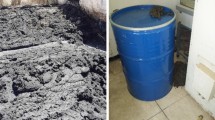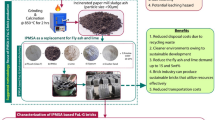Abstract
China produces large amounts of sewage sludge and agricultural waste every year. In line with the concepts of economic and environmental sustainability, the disposal of these wastes has become increasingly urgent. This paper proposes a feasible way to use river sediments, sewage sludge, and wheat straw as raw materials for sintered shale bricks. The critical processes of best humidity conditions, molding pressure, and sintering temperature were studied and analyzed to determine the optimal production parameters. Moreover, the physical and mechanical properties were investigated to assess their suitability as a partial replacement for the shale in fired-shale bricks. The results showed that moist mixtures with the maximum dry density, the molding pressure of 2 MPa, and a sintering temperature of 1050 ℃ were the optional condition to sinter high-quality bricks. Overall, the mechanical strength of bricks tended to slightly decrease with the 10–30% substitution of shale by river sediments, which showed a sharp fall with the 1–3% incorporation of sewage sludge and wheat straw, implying that massive organic matters could enhance the porosity of bricks during the sintering process. The bulk density, thermal conductivity coefficient, and drying shrinkage tended to decrease, whereas water absorption increased as three raw materials increased. Additionally, the sewage sludge and wheat straw have a positive inhibiting effect on the sintering shrinkage due to the expansion burned from massive organic matter. At the replacement level of 10–30% river sediments, 1–2% sewage sludge, and 1% wheat straw, bricks with the characteristics of low thermal conductivity, lightweight, and high strength were successfully manufactured according to the Chinese Standards.


















Similar content being viewed by others
References
Basto PD, Savastano H, Neto AAD (2019) Characterization and pozzolanic properties of sewage sludge ashes (SSA) by electrical conductivity. Cem Concr Compos 104:103410. https://doi.org/10.1016/j.cemconcomp.2019.103410
Jamora JB, Gudia SEL, Go AW, Giduquio MB, Loretero ME (2020) Potential CO2 reduction and cost evaluation in use and transport of coal ash as cement replacement: a case in the Philippines. Waste Manag 103:137–145. https://doi.org/10.1016/j.wasman.2019.12.026
Lehne J, Preston F (2018) Making Concrete Change Innovation in Low-carbon Cement and Concrete. In: proceedings of the Chatham House Report, London, UK, Energy Environment and Resources Department
China Building Materials Federation (2020) 中国建筑材料工业碳排放报告 (2020年度) . http://www.cbmf.org/cbmf/yw/7063198/index.html. Accessed 21 Feb 2022. (In Chinese)
Beall C (2004) Masonry design and detailing: for architects, engineers, and contractors. McGraw-Hill, New York
China Building Materials Federation (2021) 砖瓦行业碳达峰行动方案. http://www.cbminfo.com/cbmf/xydt/xyxx/7112436/index.html. Accessed 20 Oct 2021. (In Chinese)
DPT (2001) Substance of industrial raw materials subsoil industrial raw materials 2. State planning organization publications, Lefkoşa
General Office of the State Council of the People's Republic of China (2008) 关于进一步推进墙体材料革新和推广节能建筑的通. http://www.gov.cn/gongbao/content/2005/content_64267.htm. Accessed 28 March 2008. (In Chinese)
Farah A, Abdul G, Yasir J, Majeed IM (2019) Effect of sintering temperature on mechanical and thermophysical properties of biowaste-added fired clay bricks. J Mater Cycles Waste Manag 21:503–524. https://doi.org/10.1007/s10163-018-0810-x
Bouachera R, Kasimi R, Ibnoussina M, El Aoud M, Taha Y, El Boudour H, Idrissi El, Hakkou R (2022) The clayey quarry sludge from a waste to a valuable raw material for red ceramics. J Mater Cycles Waste Manag 24:1047–1058. https://doi.org/10.1007/s10163-022-01383-z
Kizinievič O, Kizinievič V, Boris R, Girskas G, Malaiškienė J (2018) Eco-efficient recycling of drinking water treatment sludge and glass waste: development of ceramic bricks. J Mater Cycles Waste Manag 20:1228–1238. https://doi.org/10.1007/s10163-017-0688-z
Kizinievič O, Voišnienė V, Kizinievič V, Pundienė I (2022) Impact of municipal solid waste incineration bottom ash on the properties and frost resistance of clay bricks. J Mater Cycles Waste Manag 24:237–249. https://doi.org/10.1007/s10163-021-01314-4
Lee JS, Yoo HM, Park SW, Cho SJ, Seo YC (2016) Recycling of cathode ray tube panel glasses as aggregates of concrete blocks and clay bricks. J Mater Cycles Waste Manag 18:552–562. https://doi.org/10.1007/s10163-015-0350-6
Lin D-F, Luo H-L, Lin J-D, Zhuang M-L (2018) Characterizations of temperature effects on sintered ceramics manufactured with waste foundry sand and clay. J Mater Cycles Waste Manag 20:127–136. https://doi.org/10.1007/s10163-016-0553-5
Xu H, Song W, Cao W, Shao G, Lu H, Yang D, Chen D, Zhang R (2017) Utilization of coal gangue for the production of brick. J Mater Cycles Waste Manag 19:1270–1278. https://doi.org/10.1007/s10163-016-0521-0
Eliche-Quesada D, Corpas-Iglesias FA (2014) Utilisation of spent filtration earth or spent bleaching earth from the oil refinery industry in clay products. Ceram Int 40:16677–16687. https://doi.org/10.1016/j.ceramint.2014.08.030
Lin KL (2006) Feasibility study of using brick made from municipal solid waste incinerator fly ash slag. J Hazard Mater 137:1810–6. https://doi.org/10.1016/j.jhazmat.2006.05.027
Pe’rez-Villarejo L, Corpas-Iglesias FA, Martı’nez-Martı’nez S, Artiaga R, Pascual-Cosp J (2012) Manufacturing new ceramic materials from clay and red mud derived from the aluminum industry. Constr Build Mater 35:656–665. https://doi.org/10.1016/j.conbuildmat.2012.04.133
Hamer K, Karius V (2002) Brick production with dredged harbor sediments. An industrial-scale experiment. Waste Manag 22(5):521–530. https://doi.org/10.1016/S0956-053X(01)00048-4
Samara M, Lafhaj Z, Chapiseau C (2009) Valorization of stabilized river sediments in fired clay bricks: factory scale experiment. J Hazard Mater 163(2–3):701–710. https://doi.org/10.1016/j.jhazmat.2008.07.153
Esmeray E, Ats M (2019) Utilization of sewage sludge, oven slag and fly ash in clay brick production. Constr Build Mater 194:110–121. https://doi.org/10.1016/j.conbuildmat.2018.10.231
Xu Y, Yan CH, Xu BT, Ruan XH, Wei Z (2014) The use of urban river sediments as a primary raw material in the production of highly insulating brick. Ceram Int 40(6):8833–8840. https://doi.org/10.1016/j.ceramint.2014.01.105
Karius V, Hamer K (2001) pH and grain-size variation in leaching tests with bricks made of harbor sediments compared to commercial bricks. Sci Total Environ 278(1–3):73–85. https://doi.org/10.1016/S0048-9697(00)00889-5
Wei LL, Zhu FY, Li QY, Xue CH, Xia XH, Yu H, Zhao QL, Jiang JQ, Bai SW (2020) Development, current state and future trends of sludge management in China: Based on exploratory data and CO2-equivalent emissions analysis. Environ Int 144:106093. https://doi.org/10.1016/j.envint.2020.106093
www.chyxx.com (2018) 2018年中国城镇污泥处理处置规模、污水污泥产量及污泥产生量预测. https://www.chyxx.com/industry/201912/822783.html, 2019-12-27/2022-02-11. Accessed 27 Dec 2019. (In Chinese)
Ukwatta A, Mohajerani A, Setunge S, Eshtiaghi N (2015) Possible use of biosolids in fired-clay bricks. Constr Build Mater 91:86–93. https://doi.org/10.1016/j.conbuildmat.2015.05.033
Luo LQ, Li KY, Fu W, Liu C, Yang SY (2020) Preparation, characteristics and mechanisms of the composite sintered bricks produced from shale, sewage sludge, coal gangue powder and iron ore tailings. Constr Build Mater 232:117250. https://doi.org/10.1016/j.conbuildmat.2019.117250
Abdel-Gawwad HA, Sanad SA, Mohammed MS (2020) A clean approach through sustainable utilization of cement kiln dust, hazardous lead-bearing, and sewage sludges in the production of lightweight bricks. J Clean Prod 273:123129. https://doi.org/10.1016/j.jclepro.2020.123129
Montero MA, Jordan MM, Hernandez-Crespo MS, Sanfeliu T (2009) The use of sewage sludge and marble residues in the manufacture of ceramic tile bodies. Appl Clay Sci 46(4):404–408. https://doi.org/10.1016/j.clay.2009.10.013
Xu Y, Yan CH, Xu BT, Shao Y, Ruan XH (2013) A study on the properties and modification test of the dredged material of an urban river. Hydrogeol Eng Geol 40(1):110–114. https://doi.org/10.16030/j.cnki.issn.1000-3665.2013.01.025 (In Chinese)
Liew AG, Idris A, Wong CHK, Samad AA, Noor MJMM, Baki AM (2004) Incorporation of sewage sludge in clay brick and its characterization. Waste Manag Res 22(4):226–233. https://doi.org/10.1177/0734242X04044989
Cantor DM, Manea DL (2015) Innovative building materials using agricultural waste. In: 8th International Conference on Interdisciplinarity in Engineering (Inter-Eng). Procedia Technology, Tirgu Mures, Romania, pp 456–462
China MOEAEOTPSROM (2020) Announcement of the second national pollution sources census. https://www.mee.gov.cn/home/ztbd/rdzl/wrypc/pcyw/202006/t20200616_784737.html. Accessed 16 June 2020. (In Chinese)
Korjenic A, Zach J, Hroudova J (2016) The use of insulating materials based on natural fibers in combination with plant facades in building constructions. Energy Build 116:45–58. https://doi.org/10.1016/j.enbuild.2015.12.037
Bories C, Vedrenne E, Paulhe-Massol A, Vilarem G, Sablayrolles C (2016) Development of porous fired clay bricks with bio-based additives: Study of the environmental impacts by life cycle assessment (LCA). Constr Build Mater 125:1142–1151. https://doi.org/10.1016/j.conbuildmat.2016.08.042
Aouba L, Bories C, Coutand M, Perrin B, Lemercier H (2016) Properties of fired clay bricks with incorporated biomasses: cases of olive stone flour and wheat straw residues. Constr Build Mater 102:7–13. https://doi.org/10.1016/j.conbuildmat.2015.10.040
Ahmadi R, Souri B, Ebrahimi M (2020) Evaluation of wheat straw to insulate fired clay hollow bricks as a construction material. J Clean Prod 254:120043. https://doi.org/10.1016/j.jclepro.2020.120043
Ministry of Water Resources of the PRC (1999) Specification of soil test, SL237-1999. Standards Press of China, Beijing
General Administration of Quality Supervision, Inspection and Quarantine of the People’s Republic of China, Standardization Administration (2019) Standard for geotechnical testing method, GB/T 50123 -2019. Standards Press of China, Beijing
Sakhare VV, Ralegaonkar RV (2016) Use of bio-briquette ash for the development of bricks. J Clean Prod 112:684–689. https://doi.org/10.1016/j.jclepro.2015.07.088
General Administration of Quality Supervision, Inspection and Quarantine of the People’s Republic of China, Standardization Administration (2020) Method of testing cements- determination of strength, GB/T 17671-2020. Standards Press of China, Beijing.
General Administration of Quality Supervision, Inspection and Quarantine of the People’s Republic of China, Standardization Administration (2012) Test methods of wall bricks, GB/T 2542-2012. Standards Press of China, Beijing
General Administration of Quality Supervision, Inspection and Quarantine of the People’s Republic of China, Standardization Administration (2008) Thermal insulation-determination of steady-state thermal resistance and related properties heat flow meter apparatus, GB /T 10295-2008. Standards Press of China, Beijing
Lü HB, Qian LY, Chang HS, Liu L, Zhao YL (2016) Comparison of several methods for determining specific surface area of clayey soils. Chin J Geotech Eng 38(1):124–131. https://doi.org/10.11779/CJGE201601013 (In Chinese)
Feng Y, Luo XY, Lin WA, Zhan LT, Ke H, Chen YM (2013) Geotechnical properties measurement of sewage sludge at a disposal site. Rock Soil Mech 34(1):115–122. https://doi.org/10.16285/j.rsm.2013.01.018 (In Chinese)
Xie HL, Peng JH, Zhen Y, Chen Y (2012) Influence of pore-forming agents on the properties of sintered shale bricks. J Civil Environ Eng 34(02):149–154. https://doi.org/10.3969/j.issn.1674-4764.2012.0 (In Chinese)
Monteiro SN, Alexandre J, Margern JI, Saanchez R, Vieira CMF (2008) Incorporation of sludge waste from water treatment plant into red ceramic. Constr Build Mater 22(6):1281–1287. https://doi.org/10.1016/j.conbuildmat.2007.01.013
Molera J, Pradell T, Vendrell-Saz M (1998) The colours of Ca-rich ceramic pastes: origin and characterization. Appl Clay Sci 13(3):187–202. https://doi.org/10.1016/S0169-1317(98)00024-6
Maritan L, Nodari L, Mazzoli C, Milano A, Russo U (2006) Influence of firing conditions on ceramic products: experimental study on clay rich in organic matter. Appl Clay Sci 31(1–2):1–15. https://doi.org/10.1016/j.clay.2005.08.007
Gredmaier L, Banks CJ, Pearce RB (2011) Calcium and sulphur distribution in fired clay brick in the presence of a black reduction core using micro X-ray fluorescence mapping. Constr Build Mater 25(12):4477–4486. https://doi.org/10.1016/j.conbuildmat.2011.03.054
Song JG, Wang F, Bai XB, Du DM, Ju YY, Xu MH, Ji GC (2011) Effect of the sintering technology on the properties of fired brick from quartz sands. J Ceram Process Res 12(4):357–360 (In Korean)
General Administration of Quality Supervision, Inspection and Quarantine of the People’s Republic of China, Standardization Administration (2011) Fired heat preservation brick and block, GB 26538-2011. Standards Press of China, Beijing
General Administration of Quality Supervision, Inspection and Quarantine of the People’s Republic of China, Standardization Administration (2010) Permeable paving bricks and permeable pavin flags, GB/T 25993-2010. Standards Press of China, Beijing
Ashour T, Korjenic A, Korjenic S, Wu W (2015) Thermal conductivity of unfired earth bricks reinforced by agricultural wastes with cement and gypsum. Energy Build 104:139–146. https://doi.org/10.1016/j.enbuild.2015.07.016
Acknowledgements
The authors would like to graciously thank the National Nature Science Foundation of China (Grant No. 51678379) for the financial support of this work.
Author information
Authors and Affiliations
Corresponding author
Ethics declarations
Conflict of interest
The authors declare no conflicts of interest.
Additional information
Publisher's Note
Springer Nature remains neutral with regard to jurisdictional claims in published maps and institutional affiliations.
Rights and permissions
Springer Nature or its licensor holds exclusive rights to this article under a publishing agreement with the author(s) or other rightsholder(s); author self-archiving of the accepted manuscript version of this article is solely governed by the terms of such publishing agreement and applicable law.
About this article
Cite this article
Wang, Z., Li, B. & Liang, X. Utilization of river sediment, sewage sludge and wheat straw as the primary raw material in sintered-shale bricks. J Mater Cycles Waste Manag 24, 2401–2415 (2022). https://doi.org/10.1007/s10163-022-01487-6
Received:
Accepted:
Published:
Issue Date:
DOI: https://doi.org/10.1007/s10163-022-01487-6




